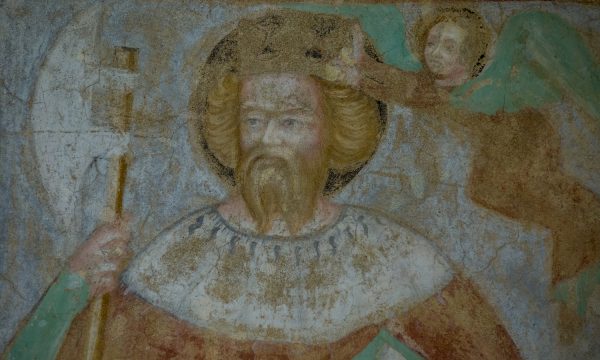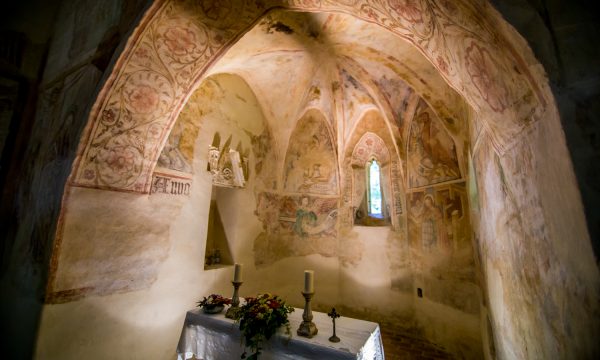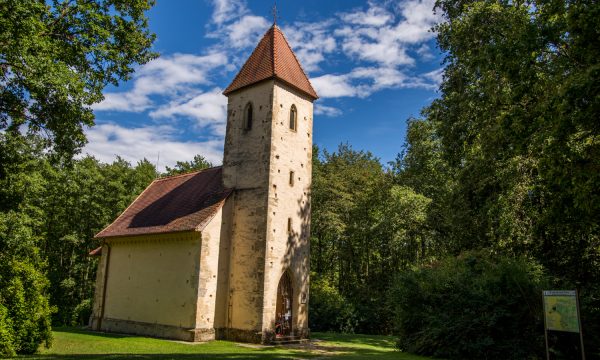Wall painting
On the territory of historic Hungary, it is rarely possible to find the name of the medieval master and to determine the exact period of his work. In the case of Velemér we are fortunate enough to know the artist, who was none other than Johannes Aquila of Radkersburg. His works created in 1377–78 cover the walls, and the master even included himself in the painting in the choir. Nothing remained from the murals on the façade, but Rómer thought to have discovered the figure of Saint Christopher on the western wall. We can form a notion of how it looked, perhaps, based on the figure of Saint Christopher also painted by him, which was partially preserved on the façade of the church in Martjanci (Hu: Mártonhely). However, his Vir dolorum painting decorating the tympanum of the portal was obliterated without a trace.

The interior walls were once completely painted, but the remaining fragments on the southern and western walls of the nave are difficult to interpret today. Only about a third of the decoration of the northern wall was preserved. Continuous surfaces have been preserved in the choir with a polygonal closure. Here we can perceive what a medieval mural cycle covering an entire surface might have looked like. Today in the choir only the concentric circles on the jamb of the eastern window and on the side of the triumphal arch facing the choir indicate the Holy Trinity. The murals on the vaulting were destroyed, but large continuous surfaces remained on its walls that can be interpreted. The veil of Veronica can be seen above its eastern window and the figures of the four evangelists appear under its archivolts. To be more precise, only two of them appear, Luke and Matthew sitting at his desk, as John and Mark are evoked through their symbols, the eagle and the lion. The figure of the painter kneeling in prayer can be seen beside Matthew on the northern wall, who can be identified through the coat of arms at his foot and a ribbon with an inscription in front of him. The artist depicted an unidentifiable woman saint holding a church model in the lower register of the northern wall, the Angelic greeting on the north-eastern and south-eastern walls, a woman saint with a slender figure, unidentifiable today, but identified by Rómer as St. Apollonia and the figure of St. Michael on the southern wall. Here, under its round window a special trompe l’oeil mural can be seen, which depicts a sacramental niche containing devotional objects.

In the nave, the largest continuous surface that remained intact is the painting of the triumphal arch. On its upper side, we can see the Last Judgment with Christ passing sentence surrounded by a mandorla in the centre, the blessed on the left and the damned on the right side. On the lower part of the triumphal arch, on its northern side we find a composition depicting the road to Calvary much like an altarpiece; on the southern side, under the canopy we find a Mettercia. Only the figure of St. Elisabeth can be identified on the southern wall of the nave today, but Rómer managed to identify the figures of St. Stephen and St. Emeric. Another large continuous painted surface was preserved on the northern wall of the nave, near the triumphal arch. In its upper register, the apostle figures in pairs placed in ogival niches were demolished, but its lower register can still be interpreted today. Master Johannes depicted the Adoration of the Magi, a huge painting that begins on the western wall. On the left side of the painting, two kings are riding towards Virgin Mary seated on a canopied throne, in front of whom Gaspar is already kneeling in adoration. Above him we can see the star of Bethlehem, the rays of which are directed to baby Jesus. Behind this composition, but not in a separate frame, we find the figure of King St. Ladislaus and bishop St. Nicholas standing beside a tower-like building. The holy king is leaning with his right hand on a huge battle-axe and rests his left hand on his sword. He wears a red cloak with ermine collar and lining. On his upper body, he wears a tight fitting green vest buttoned in the middle, and red tight-fitting hose. On the hips, he wears a belt tied in a knot at the buckle, with a dagger hanging from the belt. His presentation is similar, but his clothing greatly differs from the miniature depicting St. Ladislaus in the Illuminated Chronicle (1360). His hair and beard look very similar to those that appear on the Herma from Oradea-Győr (after 1406). His crown was stressed, emphasized through the effect of sgraffito and the holy king’s legitimacy was strengthened by the motif of angelic coronation. Above his left shoulder, an angel with wings wide spread places the crown on King Ladislaus’ head. The fragments on the western wall of the nave, which can hardly be interpreted today, are indicative of its once completely painted surfaces. On one of these fragments, on the lower left side, the figure of Virgin Mary wearing a cloak can be recognized. At one time, the figures of St. Martin on horseback sharing his cloak with a beggar and St. George, also on horseback, slaying the dragon appeared at the top of the painting, but today only some uninterpretable fragments from these can be recognized. The town of Jerusalem can be seen on the level of Virgin Mary wearing a cloak, which some say belongs to the scene of the Adoration of the Magi. Finally, the pelican feeding its young with its own blood, painted above the portal is worth mentioning, from which only its sinopia can be recognized.
Natural Heritage
Velemér village, located near the western border of Hungary, in the Inner Őrség region, holds many natural treasures. The Raba region sees the most precipitation in Hungary, and because of its peculiar climate, its vegetation is unique in the country. This environment was once defined by its deciduous and coniferous forests and waterlogged, marshy areas. The region’s most valuable habitats are the sphagnum or peat moss bogs, such as the Black Lake (Hu: Fekete-tó) or the Devil’s Lake (Hu: Ördögtó), where, alongside peat moss, purple marshlocks (Comarum palustre), menyanthes, and the round-leaved sundew (Drosera rotundifolia) live. This sundew is a carnivorous plant which feeds on insects.

Another rare species, the Hemerocallis lilioasphodelus, lives in the surrounding fens and alder groves. This flower was first discovered and described by the Belgian Carolus Clusius in 1579 close to Güssing, Austria, and it quickly became a popular ornamental plant. Its breeds have been later introduced to Hungary, but few people know that it’s place of origin is in the Őrség region. Today, it is endangered by shrublands taking over its habitats, the meadows, which are no longer cultivated because of the decline of animal farming.
The insects of the bogs are diverse, and their most colourful representatives are the butterflies like the red-brown marsh fritillary (Euphydryas aurinia), seen at the beginning of summer, and also the dusky large blue (Phengaris nausithous) and scarce large blue (Phengaris teleius) butterflies of July and August. These species are highly endangered because of their complex development processes and the loss of their habitats.
The bird life of the region is also worthy of note. The old mixed forests provide ideal nesting and feeding grounds for the often hiding black stork (Ciconia nigra), and the European honey buzzard (Pernis apivorus) also lives here. This bird mainly feeds on insect larvae. The grey-headed woodpecker’s sound, the bird itself rarely seen, can be heard from afar. The wet meadows are also home to the protected corn crake (Grey-headed woodpecker), often heard at night, and the short-eared owl (Asio flammeus) species.
